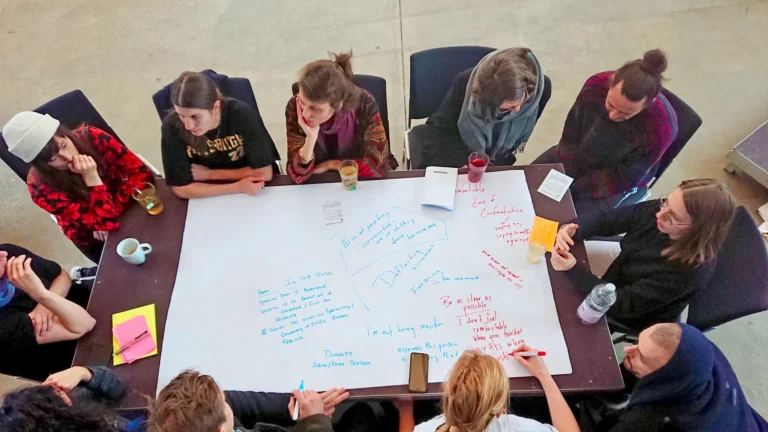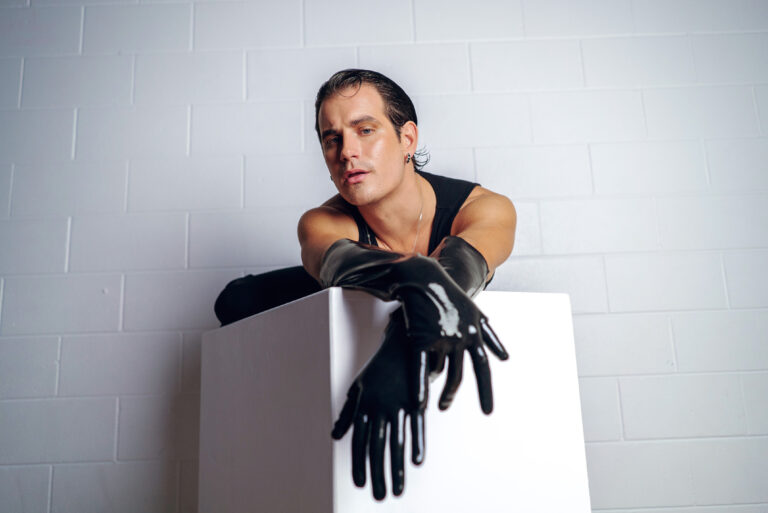Dawn Gierling and Cristian Laverde Koenig, in Antony Tudor’s The Leaves are Fading
Ask Gelsey Kirkland to elucidate her idea of classicism and it’s easy to recall the hallmarks of her dancing, all that made her genius blaze: “It’s opposite to chaos,” she says. “It’s unity, wholeness, simplicity, a quality of patience in the body, plasticity. The body has to be able to absorb and radiate light. You have to be open, and the geometry has to be clear. It has to be very organized, and the body has to be working mechanically in an efficient way that’s not pushed.”
In their yin/yang manner of discourse, Michael Chernov, Kirkland’s husband and co-artistic director of the Gelsey Kirkland Academy of Classical Ballet, chimes in with a definition that expands beyond classical ballet. “Classicism is something that is recognized through time,” he says. “What’s classical in ancient Greece is recognized now and later. That occurs because of the qualities Gelsey is referring to—the symmetry, the harmony, the wholeness.” The idea behind classicism, he proposes, dives to the root of human nature. Are we merely flesh and blood shuffling off our mortal coil or do we possess a divine spark?
With precepts like that, establishing, running and adapting a ballet school—theirs has 80 students in the professional division, 15 in the pre-professional level and five levels in the children’s division—to today’s students could be considered somewhat of a challenge, particularly in an age where hype and mediocrity too often trump classicism, not just in ballet but in the culture at large. And yet, if you watch any of the Gelsey Kirkland Ballet’s performances of chestnuts such as The Nutcracker and The Sleeping Beauty (for the 2014–15 season it’s Don Quixote), you can see the effect of the training—even in the youngest dancers. The students are encouraged to revere the components of classicism. This results in centered pirouettes; lengthened lines of the body; port de bras that’s never thrown away; well-motivated acting; buoyant jumps; a healthy relationship to space and to other dancers; and an organic sense of purpose onstage.
Kirkland and Chernov confer; (below) Eva Janiszewski teaches a summer intensive class.
In her own journey, Kirkland began as a student at The School of American Ballet, became a star at New York City Ballet as a teenager and subsequently joined American Ballet Theatre to dance the classics with Baryshnikov. Along that bumpy path, as documented in her book Dancing on My Grave, she worked with teachers such as Maggie Black and David Howard and became a muse for Balanchine, Robbins and Tudor, among others. She seemed like the perfect image of the eclecticism of American ballet: speed, drive, ambition toward perfection, perfectly streamlined technique, musicality, the versatility to dance anything with élan—sort of a Meryl Streep on pointe.
And yet, she points out, she learned classicism in reverse, backtracking from Balanchine’s neoclassicism to Petipa’s classicism. She doesn’t want her students to do that. “You can make the classical instrument go in many different directions,” she says. “I’ve experienced people who are trained in a particular neoclassical style not being able to do the classics. I’m a big believer that if you start at the center, you can move out from there. But you can’t go the other way.”
Chernov, who studied ballet and theater at the National Ballet and Theatre School in Melbourne, Australia, and the Urdang Academy in London, and danced in Europe and Australia until his retirement in 1986, offers the analogy of classical drama. “You can’t do a university course where you do four weeks of Shakespeare, four weeks of Chekhov and four weeks of Pinter,” he explains. A student needs an immersion in the spirit and language of classical theater, and a ballet dancer, they feel, needs the same with Petipa and Bournonville. “If you are doing a little bit of everything, you’ll never learn what style is, because everything will look the same—generic. That’s the summary one can make of contemporary life—that everything is becoming the same,” he adds.
And so, the GKA curriculum follows what might be considered an evolved Vaganova syllabus, which incorporates principles of alignment from Maggie Black, David Howard’s ideas about kinesiology-based movement, the core dynamics of Dreas Reyneke (who trained Kirkland at his renowned Pilates-based studio in London) and mime and acting directly with Pilar Garcia (who served as drama and mime coach to Kirkland during her ABT career). “The reason we chose Vaganova is because it’s the most logical system, the most scientifically thought-through system,” says Chernov. “We do work with the Russian system, but it’s our understanding and interpretation of all of that that makes it unique,” says Kirkland.
Summer session at the Tribeca studios
Both Kirkland and Chernov became convinced of the value of Russian-based training during their Vaganova teacher training, completed in 2003 at the Victorian College of the Arts in Australia, and two years separately with Russian master teacher Nina Osipyan, a former ballerina with the Moscow Classical Ballet. “Her teaching was the epitome of simplicity and naturalness,” says Kirkland. “The alignment was beautifully harmonious. It didn’t look pushed. I did her classes all the time and wrote them down.”
Most professional American dancers feel that their experience alone grants them the credentials to teach. But Kirkland realized that she needed to learn a step-by-step process, including the principle of “the divided exercise,” the Vaganova method of breaking down steps technically and teaching them at the appropriate ages.
When you watch Kirkland, now 61, teach in the GKA’s spacious, column-free, light-filled studios in Tribeca, the ease, fluidity and purposefulness of the movement help you to understand how she achieved the rapid-fire precision of Theme and Variations or the lyrical authenticity of her Giselle. One of the great powers of the school is the students’ opportunity to directly observe that.
Two examples of the specificity of Russian training are the use of the upper body and focus. The Russian emphasis on épaulement, the coordination of the port de bras, head and torso movement, Kirkland stresses, is often mistaken for style when it is actually organic principles of movement and balanced dancing. The focus comes when a student finds her own center and allows the diagonals of focus to emanate from that center, rather than gravitating to the corners of a studio or stage. With that clear focus, the student can relate directly to other dancers and to the stage space. When that happens, says Kirkland, “You can see a person.”
Kirkland and Chernov feel that pasting acting skills onto a dancer doesn’t work; dramatic motivation, including mime, must move through the body. “You have to find a plasticity and make choices to create a character,” says Chernov. “You have to understand how to embody your acting. And you have to train students on the classics,” like a piano student training on Mozart before experimenting with contemporary composers. The students sometimes even vocalize before class, to literally find their voice.
Kirkland and Chernov have trained five teachers in their method.
As for mime, an elusive artform for 21st-century dancers, “The first thing we tell them is it’s going to feel totally unnatural,” says Kirkland. Because storytelling through the classics is the GKA medium for developing dramatic technique, they introduce it at a young age. Last summer, the school inaugurated its Storybook Ballet Camp, for ages 3 to 8, consisting of five days covering five classical ballets: The Nutcracker, The Sleeping Beauty, Peter and the Wolf, Coppélia and Swan Lake. Each day, Pilar Garcia relates the story and teaches movement to the music.
During her performing career, Kirkland struggled mightily with the need to be perfect, an irony for many who viewed her dancing as flawless. When it comes to the GKA students, she’s determined to stop that in the doorway. “Perfectionism is the obsession,” says Chernov. “Working toward perfection is a process.”
“At the school we take in many different body types,” says Kirkland. “And so the hope is that we’ll eventually be able to work on the specifics of how to create a classical instrument within each limited body, depending on what God gave them as a gift.” Seeking perfection, in other words, can’t include the coveting of someone else’s impossibly long legs or metabolically blessed body.
What the GKA does focus on, however, is breaking bad habits that permeate much of American ballet training. “I’ve had a lot of remedial training,” says Kirkland, referring to her odyssey from eclecticism to classicism. “And that’s what we do here—fast track people. So we try to find creative ways to undo those habits and keep it interesting to them,” whether it’s unlocking a misaligned torso or re-coordinating a blockage in pirouettes en dedans.
During Storybook Ballet Camp, students learn about five classical ballets.
Alexandra Gonzalez leads a Storybook
Ballet Camp session for 3- to 8-year-olds.
Within the organization, Kirkland and Chernov have trained five teachers in their method and would like to establish relationships with other schools. But because their teacher training requires time, says Chernov, “You can’t do it the way ABT’s doing it with a two-week course. You have to embody the training.”
Kirkland and Chernov’s strength as a team works because of their symbiotic relationship. That’s partially what attracted Dawn Gierling, who has danced the leads in The Nutcracker and The Sleeping Beauty with the Gelsey Kirkland Ballet (which features 23 company members who have studied at the school, with additional casting from current students. Chernov and Kirkland want to expand it into a classical company that can rival ABT and NYCB). From Dawn’s first audition, her mother, Diane Gierling, saw that the school was the model they were looking for after trying several schools, including The Harid Conservatory. “The dynamics were there,” she says. “Misha (Chernov) wears 22 hats and he wears them well. And Gelsey’s methodology is top-notch.” In addition to the resources, such as individual coaching and access to first-rate medical specialists, such as Drs. William and Linda Hamilton, Gierling was impressed by the production values of the performances and how the dancers actually enjoyed what they were doing.
The Kirkland Ballet will perform The Nutcracker at Schimmel Center at Pace University, NYC, December 11–21. (Dancers shown are Galen Bolard and Marko Micov. )
Through the process of running a school, both Kirkland and Chernov have learned plenty: diplomacy, patience, organization, stage management and how to corral resources. “You learn what you’re good at and what you’re bad at,” says Chernov. “You learn to hand over control for what you’re bad at or what you haven’t got the energy for…but not too quickly.” DT
A former soloist with American Ballet Theatre and the Joffrey Ballet, Joseph Carman is a longtime contributor to Dance Magazine, Pointe and Dance Teacher.
Photos from top: by Luis Pons, courtesy of GKA; (6) by Kyle Froman; by Igor Siggul, courtesy of GKA



